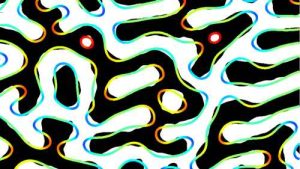From University of California Davis, Ultrafast Laser Pulses Could Lessen Storage Energy Needs
Discovery from experiment with magnets and lasers could be boon to energy-efficient storage.
This is a Press Release edited by StorageNewsletter.com on January 26, 2024 at 2:01 pm![]() By Jessica Heath, content specialist, University of California, Davis
By Jessica Heath, content specialist, University of California, Davis
A discovery from an experiment with magnets and lasers could be a boon to energy-efficient storage.
![]() “We wanted to study the physics of light-magnet interaction,” said Rahul Jangid, who led the data analysis for the project while earning his Ph.D. in materials science and engineering, UC Davis (University of California, Davis) under associate professor Roopali Kukreja. “What happens when you hit a magnetic domain with very short pulses of laser light?”
“We wanted to study the physics of light-magnet interaction,” said Rahul Jangid, who led the data analysis for the project while earning his Ph.D. in materials science and engineering, UC Davis (University of California, Davis) under associate professor Roopali Kukreja. “What happens when you hit a magnetic domain with very short pulses of laser light?”
Domains are areas within a magnet that flip from north to south poles. This property is used for storage, for example in computer hard drives.
Jangid and his colleagues found that when a magnet is hit with a pulsed laser, the domain walls in the ferromagnetic layers move at a speed of approximately 66km/s, which is about 100x faster than the speed limit previously thought.
Domain walls moving at this speed could drastically affect the way data is stored and processed, offering a means of faster, more stable memory and reducing energy consumption in spintronic devices such as hard disk drives that use the spin of electrons within magnetic metallic multilayers to store, process or transmit information.
“No one thought it was possible to move these walls that fast because they should hit their limit,” said Jangid. “It sounds absolutely bananas, but it’s true.”
It’s ‘bananas,’ because of the Walker breakdown phenomenon, which says that domain walls can only be pushed so far at a given velocity before they effectively break down and stop moving. This research, however, gives evidence that the domain walls can be driven at previously unknown velocities using lasers.
While most personal devices like laptops and cell phones use faster flash drives, data centers use cheaper, slower HDDs. However, each time a bit of information is processed, or flipped, the drive uses a magnetic field to conduct heat through a coil of wire, burning a lot of energy. If, rather, a drive could use laser pulses on the magnetic layers, the device would operate at a lower voltage and bit flips would take significantly less energy to process.
Current projections indicate that by 2030, information and communications technology will account for 21% of the world’s energy demand, exacerbating climate change. This finding, which was highlighted in a paper by Jangid and co-authors titled Extreme Domain Wall Speeds under Ultrafast Optical Excitation in the journal Physical Review Letters on December 19, comes at a time when finding energy-efficient technologies is paramount.
Representation of domain walls within a ferromagnetic layered material. New research shows that when these materials are hit with a free electron laser, magnetic domain walls move much faster than previously thought. This opens up new possibilities for energy-efficient data storage.
(Rahul Jangid, UC Davis)
When laser meets magnet
To conduct the experiment, Jangid and his collaborators, including researchers from the National Institute of Science and Technology; UC San Diego; University of Colorado, Colorado Springs and Stockholm University used the Free Electron Laser Radiation for Multidisciplinary Investigations, or FERMI facility, a free electron laser source based in Trieste, Italy.
“Free electron lasers are insane facilities,” Jangid said. “It’s a 2-mile-long vacuum tube, and you take a small number of electrons, accelerate them up to the speed of light, and at the end wiggle them to create X-rays so bright, that if you’re not careful, your sample could be vaporized. Think of it like taking all the sunlight falling on the Earth and focusing it all on a penny – that’s how much photon flux we have at free electron lasers.”
At FERMI, the group utilized X-rays to measure what occurs when a nano-scale magnet with multiple layers of cobalt, iron and nickel is excited by femtosecond pulses. A femtosecond is defined as 10 to the negative 15th of a second or one-millionth of one-billionth of a second.
“There are more femtoseconds in one second than there are days in the age of the universe,” Jangid said. “These are extremely small, extremely fast measurements that are difficult to wrap your head around.”
He was analyzing the data saw that it was these ultrafast laser pulses exciting the ferromagnetic layers that resulted in the movement of the domain walls. Based on how fast those domain walls were moving, the study posits that these ultrafast laser pulses can switch a stored bit of information approximately 1,000x faster than the magnetic field or spin current-based methods being used now.
Future of ultrafast phenomena
The technology is far from being practically applied, as current lasers consume a lot of power. However, a process similar to the way compact discs, or CDs, use lasers to store information and CD players use lasers to play it back could potentially work in the future, Jangid said.
The next steps include further exploring the physics of mechanisms that enable ultrafast domain wall velocities higher than the previously known limits, as well as imaging the domain wall motion.
This research will continue at UC Davis under Kukreja. Jangid is now pursuing similar research at National Synchrotron Light Source 2 at Brookhaven National Laboratory.
“There are so many aspects of ultrafast phenomenon that we are just starting to understand,” Jangid said. “I’m eager to tackle the open questions that could unlock transformative advancements in low power spintronics, data storage, and information processing.”
Article: Extreme Domain Wall Speeds under Ultrafast Optical Excitation
Physical Review Letters has published an article written by Rahul Jangid, Nanna Zhou Hagström, Meera Madhavi, Kyle Rockwell, Justin M. Shaw, Jeffrey A. Brock, Matteo Pancaldi, Dario De Angelis, Flavio Capotondi, Emanuele Pedersoli, Hans T. Nembach, Mark W. Keller, Stefano Bonetti, Eric E. Fullerton, Ezio Iacocca, Roopali Kukreja, and Thomas J. Silva
Abstract: “Time-resolved ultrafast EUV magnetic scattering was used to test a recent prediction of >10 km/s domain wall speeds by optically exciting a magnetic sample with a nanoscale labyrinthine domain pattern. Ultrafast distortion of the diffraction pattern was observed at markedly different timescales compared to the magnetization quenching. The diffraction pattern distortion shows a threshold dependence with laser fluence, not seen for magnetization quenching, consistent with a picture of domain wall motion with pinning sites. Supported by simulations, we show that a speed of ≈66 km/s for highly curved domain walls can explain the experimental data. While our data agree with the prediction of extreme, nonequilibrium wall speeds locally, it differs from the details of the theory, suggesting that additional mechanisms are required to fully understand these effects.“
Resources:
Extreme Domain Wall Speeds under Ultrafast Optical Excitation (Physical Review Letters)
Domain Walls Break the Sound Barrier (Physics)













 Subscribe to our free daily newsletter
Subscribe to our free daily newsletter
